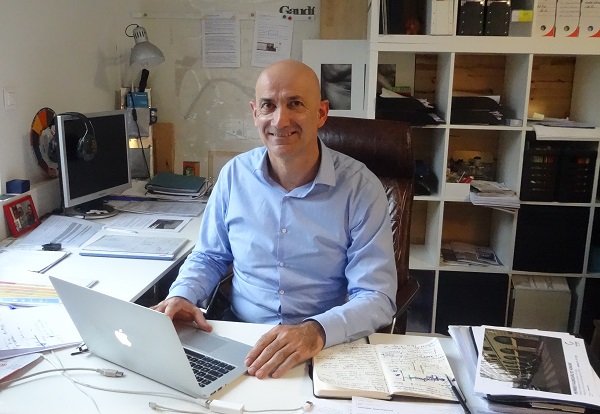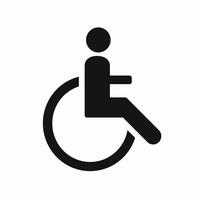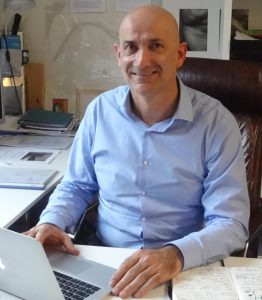
Meet architect Edouard Pastor, one of France’s leading experts on accessibility. Pastor is the founder of Handigo, an architecture and consulting firm specialized in accessibility for those in situations of disability. He has been involved in audits and accessibility programing for a number of high-profile monuments in Paris, including the Eiffel Tower, the Palais Royal and Comédie Française Theaters, the Pompidou Center and others.
Over the past 20 years, France, and Paris in particular, has made great strides in rendering accessible buildings that were formerly inaccessible to disabled or handicapped persons—those now more broadly considered to be “in a situation of disability.”
A number of factors has caused these changes: increasingly applied laws, active associations defending the rights of those with disabilities, public awareness, and architects such as Edouard Pastor, one of France’s leading architects specialized in accessibility.
“My own handicap didn’t lead me to becoming an architect,” says Pastor, who sometimes uses a wheelchair due to an accident during childhood that permanently damaged one leg. “But I feel that I’m a good consultant because in addition to my know-how I live in a situation of disability and am aware of the sense of exclusion that can come with it.”
Having opened his own office as a professional in Lyon 1988, Pastor started to become interested in accessibility in 1991 when a man who was quadriplegic asked him to design an adapted house for him.
“Being handicapped brought me into contact with others who were more heavily handicapped than I,” he says. “That job made me want to continue work in the field; I realized then that there were very few, if any, specialists in accessibility.”
The evolution of French law concerning accessibility

It was also in 1991 that France adopted a law requiring that measures of accessibility be integrated into new construction. Previously, a framework law of 1975 had outlined the general principles of accessibility, but, says Pastor, it was never applied because there was no obligation to do so. But the law of 1991 stipulated application by 1995, giving greater urgency and visibility to questions of handicap accessibility.
Honing his skills, knowledge and focus on accessibility over the following years, Pastor took on increasing amounts of work in the field, and by 2001 he considered himself singularly specialized in accessibility. The passing of the Disability Law of 2005, which codified the need to create conditions for autonomy and participation for all gave him further visibility as a specialist in the field.
That law obliged owners of private and public property that receives the public to render their property accessible to all before 2015. Though overly optimistic in its timing, the stage was set for a decree of 2014 that would turn that optimism into an obligation. Known as Ad’AP, Agenda d’accessibilité programmé (Agenda for Programed Accessibility), it required that property owners receiving the public establish by September 2017 a calendar by which they will render their properties accessible over 3, 6 or 9 years, depending on complexity, feasibility and financing.
Coinciding with the implementation of the requirement for an Ad’AP, Paris was awarded the 2024 Olympic and Paralympic Games, which will likely accelerate improved accessibility as the 2012 Games did for London.
But it wasn’t just the Olympics that made London more accessible, says Pastor. It was also because the British were “less utopian” in their view of accessibility. They understood early on the interest of “design for all,” meaning that accessibility measures should serve the greatest number of people, including those with disabilities.
“In France, we’re more regulatory; we prefer to maintain a conformity in the slope of an access ramp, and if we can’t do it we’ll propose a secondary access. That may seem correct, but in Anglo-Saxon countries that would be discriminatory. They’d rather allow everyone to pass through the same entrance even if means a slightly higher ramp slope.”
Edouard Pastor’s Paris Projects
Pastor has been involved in accessibility audits and programing for a number of high-profile monuments in Paris, including the Eiffel Tower, the Palais Royal and Comédie Française Theaters, the Pompidou Center, the National Archives, the National Library and the Musée de l’Homme. He was also involved in the actual adaptation work for the latter.

As part of the accessibility audit for the Eiffel Tower, Pastor’s evaluation outlined steps to be taken to render the tower safe for visually impaired visitors at risk of bumping into sloping girders or unable to hold securely onto rails or climb slipper steps. It was, of course, impossible to modify Gustave Eiffel’s work by moving girders that are low enough that someone might bump into them, and it was aesthetically inappropriate to attach cushioning on all of them. Pastor therefore recommended creating a discernable path that would avoid low or sloping girders, along with anti-slip steps and orientation tables with braille. Within his recommendations several solutions are possible, so it is up to the firms realizing the project to develop the final plans, expected to be completed in about five years. Regarding wheelchair accessibility, the first and second levels are already accessible, though by request from the fire department there is a derogation from making the upper level wheelchair accessible due to limited evacuation space should the elevators fail.
While Pastor’s role is to assess plans and structures in order propose solutions in view of current regulations, he is not one to insist that all historic building be adapted at any cost to the integrity of the building or regardless of the expense.
Pastor’s recommendations in preparation for the lengthy renovations at the Salle Richelieu, the historic venue of the Comédie Française, France’s premier repertory theater, are an example of his willingness to look beyond strict rules for appropriate solutions. Having been awarded the task of advising the State on questions of accessibility for the project, he recognized that it would be counterproductive to fully integrate the regulation that for every 50 seats of a theater there must be space for two wheelchair.

“On a typical night there might be two individuals in wheelchairs, perhaps occasional a small group would wish to attend a play. But removing dozens of seats in order to follow the regulation to the letter for a theater with over 800 seats would mean eliminating dozens of seats in order to provide space for 16 or so wheelchairs, space that would largely go unused.” He therefore developed a compromise proposal whereby ten wheelchair accessible places would be created while allowing for the possibility to remove additional valid seating should a larger number of individuals or a group requiring wheelchair space contact the theatre in advance. “Flexibility is to everyone’s advantage in that case,” he said.
Wheelchair access, he said, involves far more than seating spaces; elevators, rest rooms and bar areas must also be adapted. For the theater’s bar, where staff typically serve only from behind the counter, it would be ideal to have a bar counter where someone in a wheelchair could saddle up by having the wheels roll under the bar. But in order to preserve the aesthetics of the existent bar counter, Pastor instead suggested creating a separate, wheelchair accessible table and having the bar staff come over to serve.

The Pompidou Centre, though only 40 years old, was built at a time when an awareness was developing as to the need for wheelchair accessibility, but it was not designed with the needs of the visually impaired in mind. Like the Eiffel Tower, there is a similar problem with low portions that are of potential harm to visually impaired visitors. He was therefore called upon to provide advice on rendering one of the staircases safer though improved lighting, contrasting lines on steps and anti-slip material.
Gardens, too, raise questions of accessibility. Thus Pastor recently completed a mission, conferred by the Louvre, to define elements that would favor the autonomy of visually impaired individuals in the Tuileries Garden while respecting the 17th-century imprint of André Le Notre.
“The question,” he says, “is how to remove the sword of Damocles for a visually impaired person who, with each step, asks himself if he’s going to encounter an obstacle or slip or hit something.” For the Tuileries he developed strategies of placing paving stones on the ground in certain places, barriers near gardens, tactile maps near the entrance, and sound beacons that operate via Bluetooth on smartphones, all of which will eventually be put into place.
France on the forefront of recognizing four types of disability
While handicap accessibility was once generally viewed as concerning adapting buildings for people in wheelchairs, it has come increasingly to refer to four categories of handicap or disability: motor, mental/intellectual, hearing and visual. France may lag in accessibility with respect to London, says Pastor, yet it is now on the forefront, at least theoretically, of recognizing those four types of disability that must be addressed in spaces and buildings that receive the public.
Furthermore, one no longer speaks of rendering buildings accessible to disabled or handicapped persons but to those “in a situation of disability.”

“We’ve made much progress in integrating the first three types of disability,” says Pastor referring to motor, hearing and visual disabilities, “and I believe that in the next three or four years intellectual disability will come to the forefront. It’s the most complicated type of disability to understand, until one thinks about one’s own experiences. Because we can all find ourselves in situations of intellectual disability.”
Travelers need only imagine visiting China and the disorientation and frustration of being unable to decipher signs written in Chinese characters. Regular metro and RER users in Paris need only think of navigating the tunnels of the Châtelet-Les Halles station to understand how a structure’s layout, lighting and signage can induce anxiety and a feeling of being lost or entrapped.
According to INSEE, the French National Institute for Statistics and Economic Studies, 20% of French were in a situation of disability in 2016. Furthermore, there are in France about 800,000 pregnant women per year, 2.4 million children under 3 years old and, by 2025, 11% of the population will be over 75, all of whom have a direct interest in accessibility.
Derogations to the law
Pastor’s primary role now is as a consultant, advisor and auditor, assisting clients or project managers in defining, planning and programing accessibility for a property, whether a historical monument, another existing property or a new construction.
“Accessibility was long seen as an add-on, but for the past two or three years, since Ad’AP, I’m consulted before the project’s overall architect arrives in order to establish the programing of its broad principles.”
Not everything can be rendered accessible, says Pastor. There are four possible derogations in the law: cases where the structure of the building prohibits modification, cases where the heritage value needs to be protected (i.e. adapting for accessibility would degrade the site), cases where the financial cost would be unreasonable, and cases where the modifications would be unreasonable.
As Pastor’s career has evolved along with the law and public awareness concerning accessibility, so has his reputation. In 2008 he moved to Paris from Lyon and founded the firm Handigo, which now has two architects and three urbanists/programists along with a part-time secretary.

One of Handigo’s current contracts is with the European Parliament. In 2015 the firm was awarded the multiyear task of homogenizing accessibility among official European Union buildings throughout the union. That involves auditing dozens of buildings, beginning with those in Strasbourg, Luxembourg and Brussels, followed by those in each country of the EU, while taking into consideration the different standards in each country along with strong French regulations and international standards. In particular, Handigo’s mission for the European Parliament is to develop “reasonable” propositions that favor the autonomy of those in situations of sensorial disability, broadly concerning visual and auditory disabilities.
In 2011 Handigo was awarded the contract to consult for and then accompany the total renovation of the Musée de l’Homme at Trocadero in Paris. Built in 1937, the museum’s interior was mostly gutted and rebuilt and Handigo was involved in all stages, even working with the museographers and scenographers to ensure full accessibility. The end result is a visit that, unbeknownst to most visitors, allows access to the four types of disability: display cases have room underneath to allow for someone in a wheelchair, lighting and signage is sufficiently contrasted and large enough to be read by the visually impaired, braille notices, and there are adapted acoustics and an intuitive flow through the museum.
As an uncommon specialist, Pastor is often called upon to give seminars to other architects, notably to those involved in adapting heritage sites, the Chief Architects of Historical Monuments.
“Architects involved with historical buildings are often wary that rendering a building accessible will denature the structure. They’ll work on lighting whereas the original building had no electricity and they’ll work on toilets where it had no toilets. They see that as an obligation of use. But accessibility has a negative connotation though it’s also part of its contemporary use. These architects have the power to say no, but that’s less and less the case because of social pressure in addition to the law.”
“A structure’s adaptation may seem correct, but from the point of view of someone living in a situation of disability it feels completely off the mark. [Yet] it’s possible to do something nice, something beautiful, and to remove the negative connotations of accessibility.”
* * *
For information about accessible monuments, museums and restaurants in Paris and elsewhere in France, see part 2 of this article.
In November 2017 Gary Lee Kraut organized an event for the French press to inform members of the Association des Journalistes du Patrimoine about issues concerning accessibility of historical monuments. The event featured presentations and informal discussions with architects Edouard Pastor and Mirabelle Croizier. A summary account of that event can be found in French here.
© Gary Lee Kraut
This article was first published in a slightly different version in the October 2017 issue of The Connexion.

